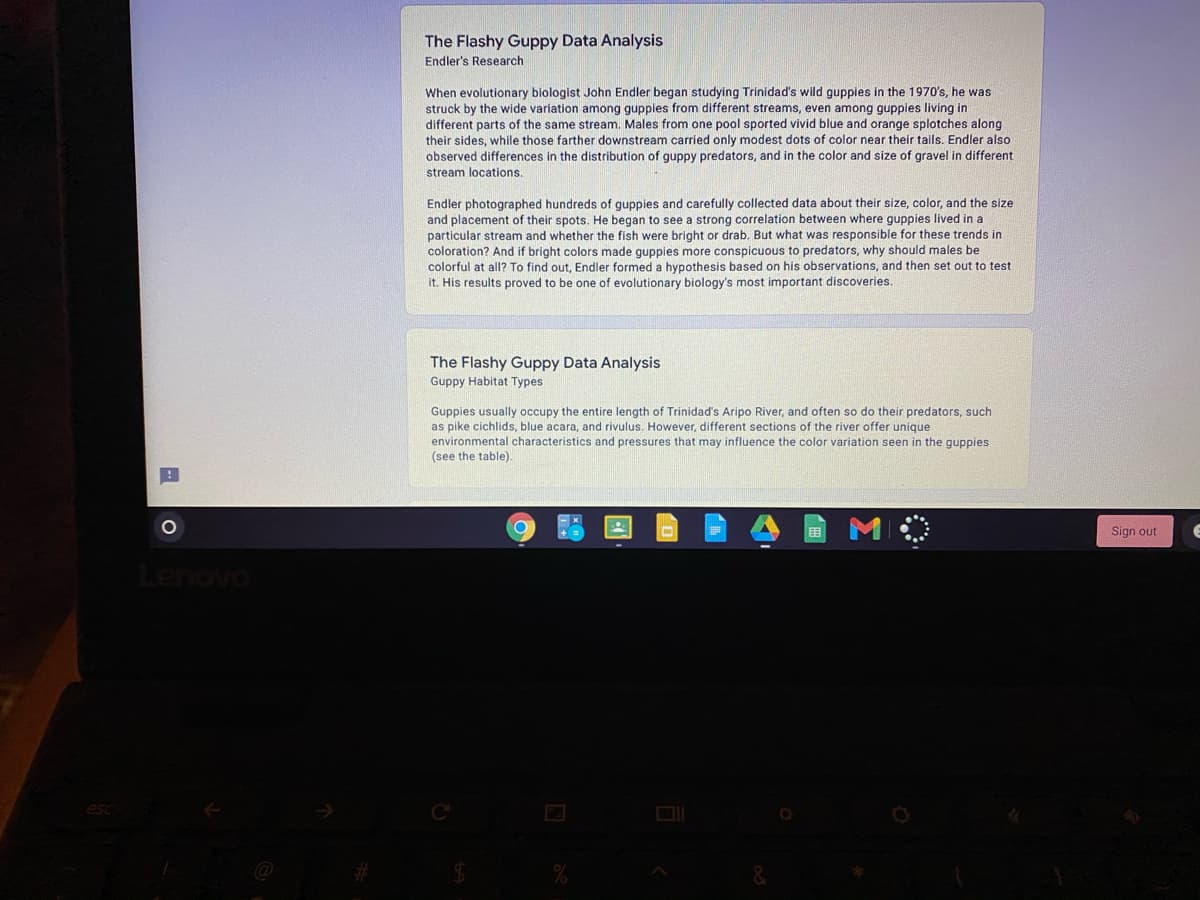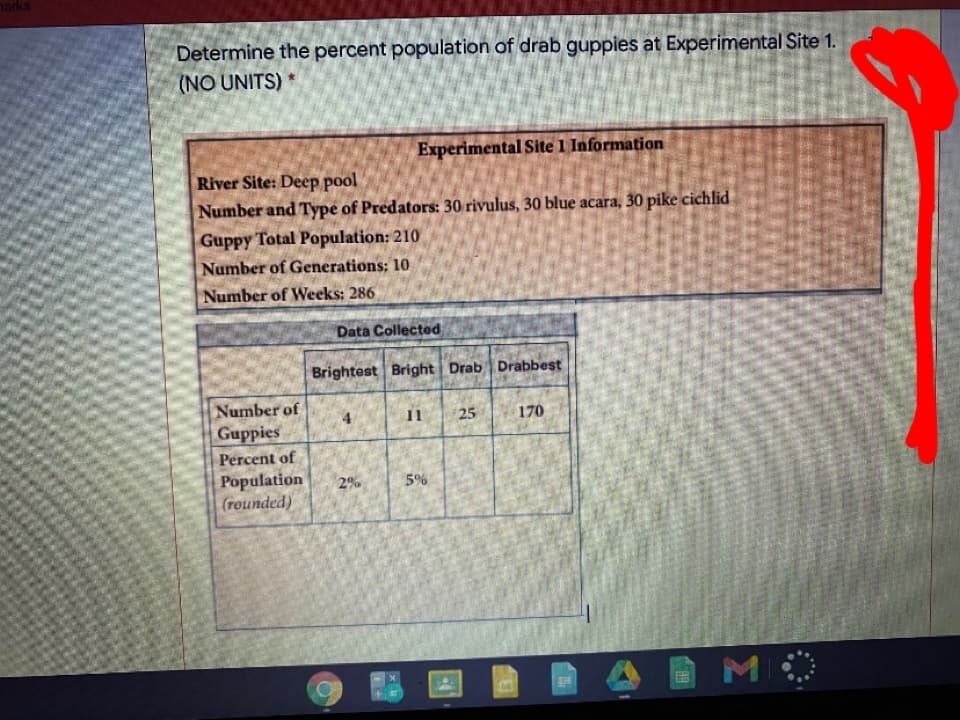Experimental Site 1 Information River Site: Deep pool Number and Type of Predators: 30 rivulus, 30 blue acara, 30 pike cichlid Guppy Total Population: 210 Number of Generations: 10 Number of Weeks: 286 Data Collected Brightest Bright Drab Drabbest Number of Guppies 11 25 170 Percent of Population (rounded) 2% 5%
Experimental Site 1 Information River Site: Deep pool Number and Type of Predators: 30 rivulus, 30 blue acara, 30 pike cichlid Guppy Total Population: 210 Number of Generations: 10 Number of Weeks: 286 Data Collected Brightest Bright Drab Drabbest Number of Guppies 11 25 170 Percent of Population (rounded) 2% 5%
Biology Today and Tomorrow without Physiology (MindTap Course List)
5th Edition
ISBN:9781305117396
Author:Cecie Starr, Christine Evers, Lisa Starr
Publisher:Cecie Starr, Christine Evers, Lisa Starr
Chapter12: Processes Of Evolution
Section: Chapter Questions
Problem 4DID
Related questions
Question
Determine The percent of population of drop guppies

Transcribed Image Text:The Flashy Guppy Data Analysis
Endler's Research
When evolutionary biologist John Endler began studying Trinidad's wild guppies in the 1970's, he was
struck by the wide variation among guppies from different streams, even among guppies living in
different parts of the same stream. Males from one pool sported vivid blue and orange splotches along
their sides, while those farther downstream carried only modest dots of color near their tails. Endler also
observed differences in the distribution of guppy predators, and in the color and size of gravel in different
stream locations.
Endler photographed hundreds of guppies and carefully collected data about their size, color, and the size
and placement of their spots. He began to see a strong correlation between where guppies lived in a
particular stream and whether the fish were bright or drab. But what was responsible for these trends in
coloration? And if bright colors made guppies more conspicuous to predators, why should males be
colorful at all? To find out, Endler formed a hypothesis based on his observations, and then set out to test
it. His results proved to be one of evolutionary biology's most important discoveries.
The Flashy Guppy Data Analysis
Guppy Habitat Types
Guppies usually occupy the entire length of Trinidad's Aripo River, and often so do their predators, such
as pike cichlids, blue acara, and rivulus. However, different sections of the river offer unique
environmental characteristics and pressures that may influence the color variation seen in the guppies
(see the table).
Sign out
Lenovo

Transcribed Image Text:arks
Determine the percent population of drab guppies at Experimental Site 1.
(NO UNITS)
Experimental Site 1 Information
River Site: Deep pool
Number and Type of Predators: 30 rivulus, 30 blue acara, 30 pike cichlid
Guppy Total Population: 210
Number of Generations: 10
Number of Weeks: 286
Data Collected
Brightest Bright Drab Drabbest
Number of
11
25
170
Guppies
Percent of
Population
(rounded)
2%
5%
M
Expert Solution
This question has been solved!
Explore an expertly crafted, step-by-step solution for a thorough understanding of key concepts.
This is a popular solution!
Trending now
This is a popular solution!
Step by step
Solved in 3 steps

Knowledge Booster
Learn more about
Need a deep-dive on the concept behind this application? Look no further. Learn more about this topic, biology and related others by exploring similar questions and additional content below.Recommended textbooks for you

Biology Today and Tomorrow without Physiology (Mi…
Biology
ISBN:
9781305117396
Author:
Cecie Starr, Christine Evers, Lisa Starr
Publisher:
Cengage Learning

Biology: The Unity and Diversity of Life (MindTap…
Biology
ISBN:
9781305073951
Author:
Cecie Starr, Ralph Taggart, Christine Evers, Lisa Starr
Publisher:
Cengage Learning

Biology: The Unity and Diversity of Life (MindTap…
Biology
ISBN:
9781337408332
Author:
Cecie Starr, Ralph Taggart, Christine Evers, Lisa Starr
Publisher:
Cengage Learning

Biology Today and Tomorrow without Physiology (Mi…
Biology
ISBN:
9781305117396
Author:
Cecie Starr, Christine Evers, Lisa Starr
Publisher:
Cengage Learning

Biology: The Unity and Diversity of Life (MindTap…
Biology
ISBN:
9781305073951
Author:
Cecie Starr, Ralph Taggart, Christine Evers, Lisa Starr
Publisher:
Cengage Learning

Biology: The Unity and Diversity of Life (MindTap…
Biology
ISBN:
9781337408332
Author:
Cecie Starr, Ralph Taggart, Christine Evers, Lisa Starr
Publisher:
Cengage Learning

Biology (MindTap Course List)
Biology
ISBN:
9781337392938
Author:
Eldra Solomon, Charles Martin, Diana W. Martin, Linda R. Berg
Publisher:
Cengage Learning

Concepts of Biology
Biology
ISBN:
9781938168116
Author:
Samantha Fowler, Rebecca Roush, James Wise
Publisher:
OpenStax College
